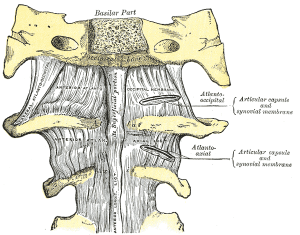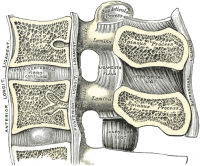Anterior longitudinal ligament
Original Editor - Rachael Lowe
Top Contributors - Kim Jackson, Andeela Hafeez, Rachael Lowe, Evan Thomas, 127.0.0.1, George Prudden, WikiSysop and Lucinda hampton
Description[edit | edit source]
A strong band of variable thickness and width that covers the anterior aspects of the vertebral bodies and intervertebral discs throughout the length of the vertebral column. From superficial to deep its ligamentous fibers span varying lengths:
- the deepest fibers are short intersegmental fibers
- the intermediate fibers span two to three vertebrae
- the superficial fibers span three to four vertebrae
It is thick, yet narrow, over the vertebral bodies where it is loosely bound to the periosteum. At the levels of the intervertebral disc, it widens and the fibers strongly bind to the fibrocartilage disc, the hyaline cartilage vertebral end plates, and the margins of the vertebrae.
Anatomy[edit | edit source]
A primary spine stabilizer about one-inch wide, the ALL runs the entire length of the spine from the base of the skull,via the cervical spine, thoracic spine and lumbar spine to the sacrum. It connects the front (anterior) of the vertebral body to the front of the annulus fibrosis.[1]
Attachments[edit | edit source]
It’s attached to the upper and lower edges of each vertebral body.[2]
Function[edit | edit source]
Limit extension of the vertebral column and reinforce the intervertebral disc.
Pathology/Injury[edit | edit source]
Anterior longitudinal ligament is stretched or tears, as the head snaps forward and then back again causing a whiplash injury.[3] In addition to the extremely common ligament sprains that nearly everyone experiences at some point in his or her life, ligaments can also calcify later in life. This calcification of the ligaments causes noticeable loss of flexibility and can even lead to chronic pain when a spinal nerve or the spinal cord becomes irritated or constricted as a result of the deterioration[1]
Techniques[edit | edit source]
Palpation[edit | edit source]
Located on anterior surface of the bodies of vertebral column.
Examination[edit | edit source]
Patient demonstrates limitations in mobility with focal tenderness.








